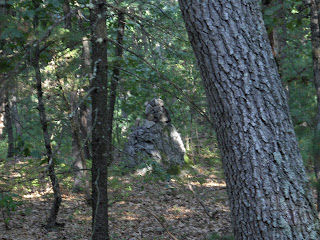By Geophile
Seeing your images made me think of this quartz item, which I picked up, among others, after an area at the top of a local hill was bulldozed. I don't go out looking for artifacts, but was searching over the newly-cleared area for quartz with crystals in it, which I've found elsewhere on this hill. This stone has a small crystal on the left side toward the bottom where there's a gap. I was struck with how much your stone and this one look alike.

Other things I've found since the bulldozing are shown here, with a regular teaspoon for scale. The stone on top seem as if it could be a hand-held blade. If you hold it in your right hand with your index finger over the top, it feels just right, and the bottom edge is like a cutting edge. The piece on the left reminds me of an axe blade, and the one on the right is like a manitou stone. It is of a different kind of stone from the other pieces, but has a worn look and feel. The blade in the first picture is shown here with its other side up.

Another view of the same pieces, the first piece now turned back over.
Are these really crafted pieces? I don't know. I do know that there are conflicting stories about whether or not there was an Indian burial ground on this hill. A Lenape town was known to be just a quarter to a half mile below. There is a lot of white quartz here, sometimes including crystals, and the wood with many springs and the quartz piles I've mentioned before is just below. Could these have been ceremonial or burial pieces? I'll probably never know.
 It is with some timidity I offer the link to Wikipedia's new (still in progress) page on ceremonial stone landscapes. It is taking me a while to understand the particulars of the Wikipedia structure, so this is anything but perfect, and will be subject to many revisions. I'm sure many of you will have suggestions and I appreciate them, but it may take time to incorporate them. I also intend to create an entry for the Oley Hills site, course not giving a location any more precise than Berks County, Pennsylvania.
It is with some timidity I offer the link to Wikipedia's new (still in progress) page on ceremonial stone landscapes. It is taking me a while to understand the particulars of the Wikipedia structure, so this is anything but perfect, and will be subject to many revisions. I'm sure many of you will have suggestions and I appreciate them, but it may take time to incorporate them. I also intend to create an entry for the Oley Hills site, course not giving a location any more precise than Berks County, Pennsylvania.










































